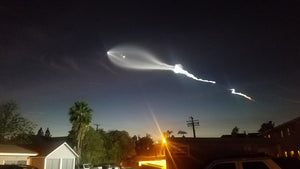Worldwide Space Schedule
Via Space.comNov. 2-3: The annual South Taurid meteor shower peaks overnight. Active from mid-September to mid-November, the Southern Taurids rarely produce more than five visible meteors per hour, but the nearly-new moon should make them easier to spot against a dark sky.
Nov. 4: The new moon arrives at 5:15 p.m. EDT (2115 GMT).
Nov. 4: Uranus is at opposition, meaning it will appear at its biggest and brightest of the year. Shining at magnitude 5.7, the planet will be visible all night long in the constellation Aries. Uranus may be visible to the naked eye from dark locations but is best seen through a telescope or binoculars.
Nov. 6: The Japan Aerospace Exploration Agency (JAXA) will use an Epsilon rocket to launch the Rapid Innovative Payload Demonstration Satellite 2 (RAISE 2), a technology demonstration mission. It will lift off from the Uchinoura Space Center in Japan at 8:48 p.m. EDT (0048 Nov. 7 GMT).
Nov. 6: A SpaceX Falcon 9 rocket will launch a Crew Dragon spacecraft on the Crew-3 mission, the third operational astronaut flight to the International Space Station. On board will be NASA astronauts Raja Chari, Thomas Marshburn and Kayla Barron, and European Space Agency astronaut Matthias Maurer. It will lift off from Launch Complex 39A at NASA's Kennedy Space Center in Florida, at 11:36 p.m. EDT (0336 Nov. 7 GMT).
Nov. 7: Daylight Saving Time ends. Turn your clocks back one hour at 2 a.m. local time.
Nov. 8: Conjunction of the moon and Venus. The waxing crescent moon will pass about 1 degree to the north of Venus. Look for the pair above the western horizon after sunset. Skywatchers in parts of Eastern Asia will see the moon occult Venus, meaning it will briefly pass in front of the planet, blocking it from sight.
Nov. 10: Conjunction of the moon and Saturn. The waxing crescent moon will swing about 4 degrees to the south of Saturn in the evening sky.
Nov. 11: Conjunction of the moon and Jupiter. The first-quarter moon will swing about 4 degrees to the south of Jupiter in the evening sky.
Nov. 11: Rocket Lab will use an Electron rocket to launch two Earth observation satellites for the Seattle-based company BlackSky Global. The mission, nicknamed "Love At First Insight," will lift off from the Mahia Peninsula in New Zealand, at 11:25 p.m. EST (0425 GMT).
Nov. 11-12: The annual North Taurid meteor shower peaks overnight. The shower, which is active from late October to mid-December, is not expected to produce more than a handful of visible "shooting stars" per hour.
Nov. 15: An Arianespace Vega rocket will launch three CERES satellites for the French military. (CERES stands for "Capacité de Renseignement d’origine Electromagnétique Spatiale," which translates to "Intelligence Capacity of Space Electromagnetic Origin.") The mission will lift off from the Guiana Spaceport near Kourou, French Guiana, at 4:27 a.m. EST (0927 GMT).
Nov. 16-17: One of the most anticipated meteor showers of the year, the Leonid meteor shower peaks overnight. The Leonids are expected to produce about 15 meteors per hour on the night of the peak, but the shower is active all month long.
Nov. 18: SpaceX will use a Falcon 9 rocket to launch the second COSMO-SkyMed Second Generation (CSG-2) radar surveillance satellite for the Italian space agency. It will lift off from Cape Canaveral Florida, at 6:11 p.m. EST (2311 GMT).
Nov. 19: The full moon of November, known as the Full Beaver Moon, occurs at 3:58 a.m. EST (0858 GMT).
Nov. 19: A partial lunar eclipse will be visible from North and South America, Australia, and parts of Europe and Asia. The moon will enter Earth's faint outer shadow, known as the penumbra, at 1:02 a.m. EST (0602 GMT). The partial eclipse, when the moon will darken more noticeably, begins at 2:18 a.m. EST (0718 GMT). Maximum eclipse occurs at 4:02 a.m. EST (0902 GMT). The entire event will last about six hours.
Nov. 22: A United Launch Alliance Atlas V rocket will launch the STP-3 rideshare mission for the U.S. Space Force. It will lift off from Cape Canaveral Space Force Station in Florida.
Nov. 24: A SpaceX Falcon 9 rocket will launch NASA's Double Asteroid Redirection Test (DART) mission from Vandenberg Air Force Base in California, at 1:20 a.m. EST (0620 GMT).
Nov. 24: Russia will use a Soyuz rocket to launch a new module to the International Space Station. The Uzlovoy Module, also known as Prichal, will dock with Russia's Nauka science module and will serve as a docking port for Russian vehicles. The mission will launch from the Baikonur Cosmodrome in Kazakhstan, at 8:06 a.m. EST (1306 GMT).
Nov. 27: Rocket Lab will use an Electron rocket to launch two Earth observation satellites for the Seattle-based company BlackSky Global. The mission will lift off from the Mahia Peninsula in New Zealand.
Nov. 30: An Arianespace Soyuz rocket will launch two satellites for Europe's Galileo navigation constellation. It will lift off from the Guiana Space Center near Kourou, French Guiana, at 7:35 p.m. EST (0035 Dec. 1 GMT).
Also scheduled to launch in November (from Spaceflight Now):
- Astra will use its Rocket 3 to launch a test payload for the U.S. Space Force and the Space Test Program. It will lift off from the Pacific Spaceport Complex on Kodiak Island, Alaska.
- A SpaceX Falcon 9 rocket may launch 51 satellites for the company's Starlink broadband internet constellation.







